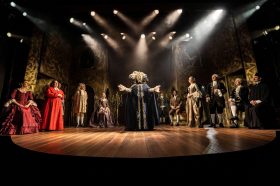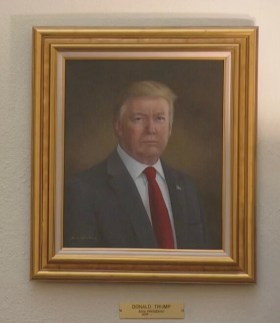Sokie Endo, Suspension Bridge via society6
How long should it take to ‘make it’? While some artists catapult from obscurity to accolades, the sentiments of 1930s American showman Eddie Cantor – that it actually takes 20 years to become an overnight success – echo a more realistic time frame for establishing a sustainable arts career – that if you’re an artist, you’re in for the long haul.
But for emerging or amateur artists who cross the proverbial divide and turn professional, the reality is there’s no set formula for forging such a pathway. There are however some things to remember which can help keep a sense of perspective.
Get the basics right first
Whether it’s formal study or building skills and knowledge informally through the fringe arts, Gasworks Arts Park Creative Producer Tony Smith said it’s important for to start with a strong foundation. ‘You don’t want to go, “here’s the set progression for you as an artist”,’ he said.
‘If you want to create a profession for yourself, just having basic skills – knowing how to budget your show, knowing how it’s going to go ok – that’s one of the key things.
‘I often see people get the core of it wrong. If I was mentoring someone for 12 months I’d be making sure they have those basics first. Know how to plan, know how to schedule, and know how to stick to it.
‘All those basic things sound really boring, but I just see it too often being about the work, which is ok, but I don’t want to see you get to the end of it, and you’re broke, and you’re tired and you’re pissed off.’
Find a way to make a living
Smith said artists should also remember to find a way to keep earning income as they build their profile and their portfolios. ‘Everyone in the arts is passionate, and almost without exception, everyone in the arts works harder than what they get paid for,’ he said.
‘Everyone delivers with much more passion than they get paid for. But even so, you don’t what to be doing it too long as an amateur. I can only speak from a performing arts background, but there’s so much money that can be lost by putting on a good show.’
Set appropriate milestones and goals
Melbourne dancer Leigh Booth said setting appropriate benchmarks and milestones helps calibrate a sense of personal achievement and accomplishment, and can determine if an artist is heading in the right direction professionally.
Having trained at Ballarat Arts Academy – formally BAPA – and under Industry Dance’s Robert Sturrock, Booth’s most recent stints as choreographer for Rhonda Burchmore’s Karralyka Centre show, and James Varnish’s Midsumma show, are markers leading to his ultimate goal of working as a musical theatre dancer. ‘I’m very fresh and just about to start with the audition circuit again because it’s been very quiet. I guess I’m trying to set myself up work wise and getting choreography jobs which I’ve been lucky to get over the last few months,’ he said.
For dancers wanting to a score musical, Booth said starting in the ensemble or as a swing is a typical pathway. ‘If you want to start understudying leads, being lead roles, then each musical you do you is a step up the ladder. You might want to become a choreographer so you become a dance captain and then the resident choreographer,’ he said.
Booth said setting specific goals and milestones also hinge on the kind of lifestyle an artist wishes to lead. ‘I know a lot of dancers who want to do the corporate and the club dancing, and a lot of them are really happy doing that – they can have their day jobs and they can just do that,’ he said.
‘For other people doing that and wanting to take a leap into music theatre, that’s a much bigger leap. And I guess it depends on when you get your first show, some people do domino.’
‘Steven Danielsen didn’t get Xanadu until he was 30 and then went on to play Fiyero in Wicked two shows later. Alicia Attwood got Chitty Chitty Bang Bang when she was almost 30. They are examples of people who have just persisted with their craft, and pushed themselves until they have broken that threshold.’
Take advantage of exhibitions, awards and funding opportunities
Canberra photographer Andrew M Lance said his level of professional recognition grew after taking out the National Photographic Portrait Prize People’s Choice Award last year. ‘There are a lot of national portraiture competitions that are open. I really enjoy submitting photographs to these competitions because it really does extend what I do,’ he said.
Snapped under the Commonwealth Avenue Bridge by Lake Burley Griffin, Lance’s self-portrait Andrew was exhibited at the National Portrait Gallery in 2014, and saw him awarded studio time at Sydney’s Sun Studios. ‘For someone like me, someone who is transitioning from amateur to professional, using that space and being in that studio for one whole day intensively was a very rewarding experience, and something I learnt a lot from,’ said Lance.
‘This past year, I have become a lot more serious with my photography, which means a lot more planning and work has gone into sessions and photo shoots. I’ve started working with people who have sought me out to take corporate portraiture and portraiture.’
Build support from institutions
Currently based in Jingdezhen, China, Sydney artist Juz Kitson has taken up opportunities to exhibit nationally and internationally in regional galleries, museums and commercial spaces ever since completing her studies at the National Art School in 2009.
Recently curated into Australia Platform at ArtStage Singapore and Today Art Museum Beijing, Kitson told ArtsHub she has also received grant funding, which has made it possible to create what would have been otherwise commercially inaccessible works. ‘Fortunately my work has been commercially accepted giving the freedom to expand into a professional realm and continue with the work I make,’ she said.
‘By having the support from GAGPROJECTS and Greenaway Art Gallery this also has helped with the transition process,’ she said.
Build rapport with a peer network
While Kitson said artistic growth comes with pushing personal and professional boundaries, building rapport with a peer-based network is vital. ‘Obviously financial support in grants and sales of work inevitably give every artist the power to “keep on keeping on”, but I do believe that it’s just as important to have the recognition amongst our peers,’ she said.
Kitson said a prime example of this was an exhibition titled Aphrodite&Hercules presents.., which she curated with Phil James in a Newtown shop front last August. The show included the work of NELL, David Griggs, Tim Bruniges, Heath Franco, PhilJames, Juz Kitson, Dan Hollier and Justin Balmain.
‘Exhibiting together in a non-commercial environment, without the expectations of sales united us regardless of how established or emerging each artist is, and brought us together in celebration as a collective of Sydney based artists all pushing there chosen materials in a contemporary context,’ she said.
Lance agrees that building a peer network has also helped to develop his craft. ‘I’m starting to get a sense of it. I’m receiving a lot of respect and I’m receiving a lot of positive feedback from my photographic peers, which may indicate that I am advancing in my photography skills. That’s probably the most tangible thing,’ he said.
And remember that you can’t always plan for everything
Booth said career acceleration in the arts can also comes down to a healthy dose of luck, or right place, right time connections – and so artists should simply stay open to the opportunities which come to them. ‘Phoebe [Panaretos] who plays Fran in Strictly Ballroom, only really had done Singin’ in the Rain with The Production Company prior to that,’ he said.
‘She has gone from ensemble in one production to a lead role. It depends on timing, what you’re right for, where you are at with your training – you can plan as best as you
‘You can put yourself into situations that will help you get those experiences, like trying to be seen by people, doing the right choreographer’s dance classes, getting singing lessons, being as proactive as you can with your skill set, and trying to further yourself as much as possible.’





